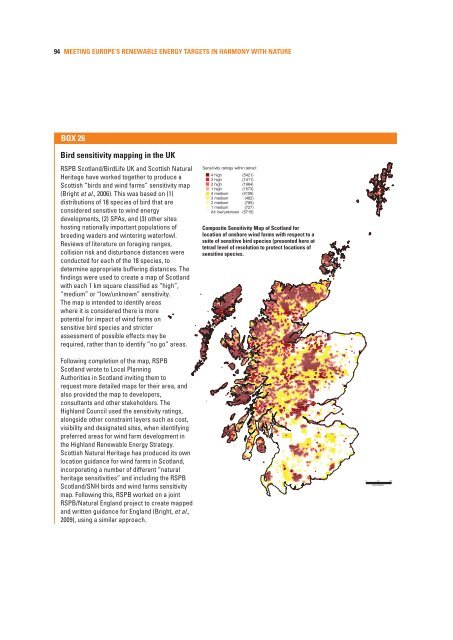Meeting Europe's renewable energy targets in harmony with - RSPB
Meeting Europe's renewable energy targets in harmony with - RSPB
Meeting Europe's renewable energy targets in harmony with - RSPB
You also want an ePaper? Increase the reach of your titles
YUMPU automatically turns print PDFs into web optimized ePapers that Google loves.
94 MEETING EUROPE’S RENEWABLE ENERGY TARGETS IN HARMONY WITH NATURE<br />
BOX 26<br />
Bird sensitivity mapp<strong>in</strong>g <strong>in</strong> the UK<br />
<strong>RSPB</strong> Scotland/BirdLife UK and Scottish Natural<br />
Heritage have worked together to produce a<br />
Scottish “birds and w<strong>in</strong>d farms” sensitivity map<br />
(Bright et al., 2006). This was based on (1)<br />
distributions of 18 species of bird that are<br />
considered sensitive to w<strong>in</strong>d <strong>energy</strong><br />
developments, (2) SPAs, and (3) other sites<br />
host<strong>in</strong>g nationally important populations of<br />
breed<strong>in</strong>g waders and w<strong>in</strong>ter<strong>in</strong>g waterfowl.<br />
Reviews of literature on forag<strong>in</strong>g ranges,<br />
collision risk and disturbance distances were<br />
conducted for each of the 18 species, to<br />
determ<strong>in</strong>e appropriate buffer<strong>in</strong>g distances. The<br />
f<strong>in</strong>d<strong>in</strong>gs were used to create a map of Scotland<br />
<strong>with</strong> each 1 km square classified as “high”,<br />
“medium” or “low/unknown” sensitivity.<br />
The map is <strong>in</strong>tended to identify areas<br />
where it is considered there is more<br />
potential for impact of w<strong>in</strong>d farms on<br />
sensitive bird species and stricter<br />
assessment of possible effects may be<br />
required, rather than to identify ”no go” areas.<br />
Sensitivity rat<strong>in</strong>gs Sensitivity <strong>with</strong><strong>in</strong> tetrad: rat<strong>in</strong>gs <strong>with</strong><strong>in</strong> tetrad:<br />
4 high 4 high (5421) (5421)<br />
3 high 3 high (1411) (1411)<br />
2 high 2 high (1964) (1964)<br />
1 high<br />
1 high<br />
(1573)<br />
(1573)<br />
4 medium (4109)<br />
4 medium<br />
3 medium<br />
(4109)<br />
(482)<br />
3 medium 2 medium (482) (785)<br />
2 medium 1 medium (785) (727)<br />
1 medium All low/unknown (727) (5715)<br />
All low/unknown (5715)<br />
Composite Sensitivity Map of Scotland for<br />
location of onshore w<strong>in</strong>d farms <strong>with</strong> respect to a<br />
suite of sensitive bird species (presented here at<br />
tetrad level of resolution to protect locations of<br />
sensitive species.<br />
Follow<strong>in</strong>g completion of the map, <strong>RSPB</strong><br />
Scotland wrote to Local Plann<strong>in</strong>g<br />
Authorities <strong>in</strong> Scotland <strong>in</strong>vit<strong>in</strong>g them to<br />
request more detailed maps for their area, and<br />
also provided the map to developers,<br />
consultants and other stakeholders. The<br />
Highland Council used the sensitivity rat<strong>in</strong>gs,<br />
alongside other constra<strong>in</strong>t layers such as cost,<br />
visibility and designated sites, when identify<strong>in</strong>g<br />
preferred areas for w<strong>in</strong>d farm development <strong>in</strong><br />
the Highland Renewable Energy Strategy.<br />
Scottish Natural Heritage has produced its own<br />
location guidance for w<strong>in</strong>d farms <strong>in</strong> Scotland,<br />
<strong>in</strong>corporat<strong>in</strong>g a number of different “natural<br />
heritage sensitivities” and <strong>in</strong>clud<strong>in</strong>g the <strong>RSPB</strong><br />
Scotland/SNH birds and w<strong>in</strong>d farms sensitivity<br />
map. Follow<strong>in</strong>g this, <strong>RSPB</strong> worked on a jo<strong>in</strong>t<br />
<strong>RSPB</strong>/Natural England project to create mapped<br />
and written guidance for England (Bright, et al.,<br />
2009), us<strong>in</strong>g a similar approach.<br />
0<br />
50<br />
kilometres<br />
100
















